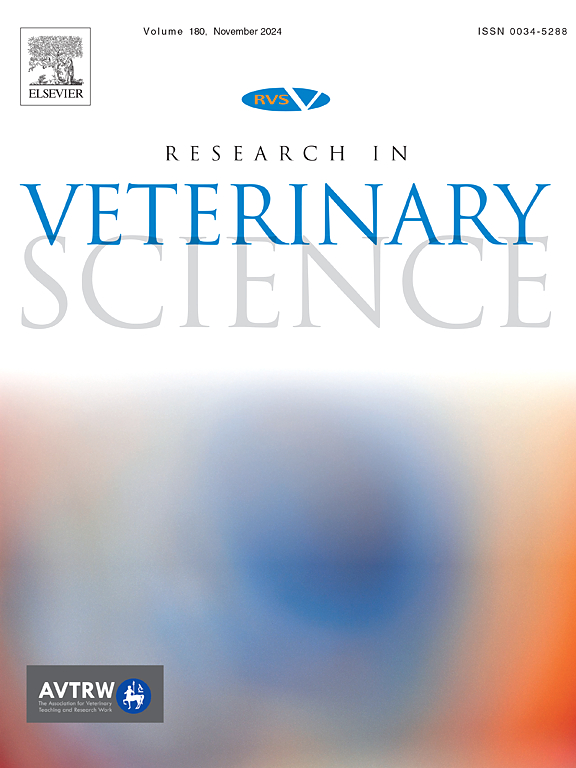Sero-epidemiological survey on novel chamois respirovirus in alpine chamois (Rupicapra rupicapra rupicapra) and domestic small ruminants
IF 2.2
3区 农林科学
Q1 VETERINARY SCIENCES
引用次数: 0
Abstract
The emergence of novel pathogens at the wildlife-livestock interface is an increasing global concern, with implications that extend beyond regional ecosystems, due to their potential impacts on biodiversity, animal health, and public health worldwide. A novel respirovirus phylogenetically related to Caprine respirovirus 3 (CRV3) identified in goats and sheep in China, was recently identified in Alpine chamois (CHRV3). In this context, this study investigates the seroprevalence of CHRV3 in chamois and domestic small ruminant populations, encompassing areas with varying levels of wildlife and livestock interaction in northern Italy and exploring the potential for cross-species transmission. Sera from 620 animals, including chamois, goats, and sheep, were tested for antibodies against CHRV3 and bovine respirovirus (BRV3) for cross-reactivity purposes. Results revealed a sustained circulation of CHRV3 in chamois population where it was previously detected, with significantly higher seroprevalence compared to BRV3. Sheep exhibited higher CHRV3 seroprevalence than goats, suggesting a possible role in transmission dynamics. Factors such as flock size, species, and seasonal grazing were significantly associated with seropositivity in domestic ruminants. These findings underscore the potential for CHRV3 cross-species transmission and its implications for wildlife conservation and livestock health. Continuous monitoring and integrative management strategies are essential to mitigate the spread of such emerging pathogens.
新型病原体在野生动物与家畜交界处的出现日益引起全球关注,由于其对生物多样性、动物健康和全球公共卫生的潜在影响,其影响范围已超出区域生态系统。最近在阿尔卑斯麂身上发现了一种新型呼吸病毒(CHRV3),它与在中国山羊和绵羊身上发现的家畜呼吸病毒 3(CRV3)在系统发育上具有亲缘关系。在此背景下,本研究调查了CHRV3在驼科动物和家养小反刍动物种群中的血清流行情况,包括意大利北部不同程度的野生动物和家畜互动地区,并探讨了跨物种传播的可能性。出于交叉反应的目的,对 620 头羚羊、山羊和绵羊的血清进行了 CHRV3 和牛呼吸病毒 (BRV3) 抗体检测。结果显示,CHRV3 在麂子群体中持续流行,与 BRV3 相比,其血清流行率明显更高。绵羊的CHRV3血清流行率高于山羊,这可能与传播动态有关。羊群大小、种类和季节性放牧等因素与家养反刍动物的血清阳性率明显相关。这些发现强调了 CHRV3 跨物种传播的可能性及其对野生动物保护和牲畜健康的影响。持续监测和综合管理策略对于减少此类新病原体的传播至关重要。
本文章由计算机程序翻译,如有差异,请以英文原文为准。
求助全文
约1分钟内获得全文
求助全文
来源期刊

Research in veterinary science
农林科学-兽医学
CiteScore
4.40
自引率
4.20%
发文量
312
审稿时长
75 days
期刊介绍:
Research in Veterinary Science is an International multi-disciplinary journal publishing original articles, reviews and short communications of a high scientific and ethical standard in all aspects of veterinary and biomedical research.
The primary aim of the journal is to inform veterinary and biomedical scientists of significant advances in veterinary and related research through prompt publication and dissemination. Secondly, the journal aims to provide a general multi-disciplinary forum for discussion and debate of news and issues concerning veterinary science. Thirdly, to promote the dissemination of knowledge to a broader range of professions, globally.
High quality papers on all species of animals are considered, particularly those considered to be of high scientific importance and originality, and with interdisciplinary interest. The journal encourages papers providing results that have clear implications for understanding disease pathogenesis and for the development of control measures or treatments, as well as those dealing with a comparative biomedical approach, which represents a substantial improvement to animal and human health.
Studies without a robust scientific hypothesis or that are preliminary, or of weak originality, as well as negative results, are not appropriate for the journal. Furthermore, observational approaches, case studies or field reports lacking an advancement in general knowledge do not fall within the scope of the journal.
 求助内容:
求助内容: 应助结果提醒方式:
应助结果提醒方式:


